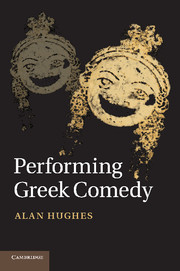Book contents
- Frontmatter
- Contents
- Illustrations
- Preface
- Chapter 1 Comedy in art, Athens and abroad
- Chapter 2 Poets of Old and Middle Comedy
- Chapter 3 Theatres
- Chapter 4 The comic chorus
- Chapter 5 Music in comedy
- Chapter 6 Acting, from lyric to dual consciousness
- Chapter 7 Technique and style of acting comedy
- Chapter 8 The masks of comedy
- Chapter 9 Costumes of Old and Middle Comedy
- Chapter 10 Comedy and women
- Chapter 11 New Comedy
- Catalogue of objects discussed
- Notes
- Glossary
- Bibliography
- Index
Chapter 9 - Costumes of Old and Middle Comedy
Published online by Cambridge University Press: 05 February 2012
- Frontmatter
- Contents
- Illustrations
- Preface
- Chapter 1 Comedy in art, Athens and abroad
- Chapter 2 Poets of Old and Middle Comedy
- Chapter 3 Theatres
- Chapter 4 The comic chorus
- Chapter 5 Music in comedy
- Chapter 6 Acting, from lyric to dual consciousness
- Chapter 7 Technique and style of acting comedy
- Chapter 8 The masks of comedy
- Chapter 9 Costumes of Old and Middle Comedy
- Chapter 10 Comedy and women
- Chapter 11 New Comedy
- Catalogue of objects discussed
- Notes
- Glossary
- Bibliography
- Index
Summary
Articles of clothing are amongst the most frequently named objects in extant comedies and fragments. Stage costume serves as a narrative device, and a visual signifier of character and status. Because garments worn by actors were in many respects the same as everyday dress, Greek audiences read their subtle codes with ease, but a modern audience or costume designer may be baffled by terminology. ‘Where did you get that thoimation?’ asks an Informer. ‘Yesterday I saw you wearing a tribonion’ (Wealth 881–2). The Informer's words are a verbal stage direction, prescribing what the Honest Man must wear in an earlier scene as well as in this one. Evidently he has changed his clothes, but what sort of change is implied? Have overalls replaced his Sunday suit? If a gloss explains that he has exchanged a homespun cloak for a woollen one, we may understand that his fortunes have improved, but we may not be able to visualize both garments. When we turn to images the Greeks made of comedies in action, we are inevitably puzzled. Much of our evidence for comedy in the classical age is visual, designed to communicate within a specific culture, time and place. If we are to understand comedy, we must attempt to decode its visual language.
Old and Middle Comedy flourished longer than modern Greece has been a nation. Beginning as an amateur choral event on the fringe of an Athenian festival, it was gradually transformed into a narrative performed by transnational celebrities. It would be strange if costume conventions failed to evolve. Fortunately, visual evidence is now abundant enough to permit us to glimpse some of the earliest comic costumes, and to follow developments during much of the classical period.
- Type
- Chapter
- Information
- Performing Greek Comedy , pp. 178 - 200Publisher: Cambridge University PressPrint publication year: 2011



